The Campo de Dalias GNSS Network Unveils the Interaction between Roll-Back and Indentation Tectonics in the Gibraltar Arc
Abstract
:1. Introduction
2. Geological Setting
3. GNSS Equipment and Data Processing
4. GNSS Network Results
5. Recent Offshore Active Tectonic Deformations West of the Campo de Dalias
6. Discussion
7. Conclusions
Author Contributions
Funding
Institutional Review Board Statement
Informed Consent Statement
Data Availability Statement
Conflicts of Interest
References
- Elliott, J.R.; Walters, R.J.; Wright, T.J. The role of space-based observation in understanding and responding to active tectonics and earthquakes. Nat. Commun. 2016, 7, 13844. [Google Scholar] [CrossRef] [PubMed] [Green Version]
- Kreemer, C.; Blewitt, G.; Klein, E.C. A geodetic plate motion and Global Strain Rate Model. Geochem. Geophys. Geosyst. 2014, 15, 3849–3889. [Google Scholar] [CrossRef]
- Tsukahara, K.; Takada, Y. Aseismic fold growth in southwestern Taiwan detected by InSAR and GNSS. Earth Planets Space 2018, 70, 52. [Google Scholar] [CrossRef] [Green Version]
- Azzaro, R.; Bonforte, A.; D’Amico, S.; Guglielmino, F.; Scarfì, L. Stick-slip vs. stable sliding fault behaviour: A case-study using a multidisciplinary approach in the volcanic region of Mt. Etna (Italy). Tectonophysics 2020, 790, 228554. [Google Scholar] [CrossRef]
- Allmendinger, R.W.; Loveless, J.P.; Pritchard, M.E.; Meade, B. From decades to epochs: Spanning the gap between geodesy and structural geology of active mountain belts. J. Struct. Geol. 2009, 31, 1409–1422. [Google Scholar] [CrossRef] [Green Version]
- Vardar, D.; Alp, H.; Demirel, S.; Vardar, H.A.; Alpar, B. Offshore/onshore correlation of the North-Anatolian fault deformations in the Western Sea of Marmara. Nat. Hazards 2021, 107, 1905–1923. [Google Scholar] [CrossRef]
- Platt, J.P.; Vissers, R.L.M. Extensional collapse of thickened continental lithosphere: A working hypothesis for the Alboran Sea and Gibraltar arc. Geology 1989, 17, 540–543. [Google Scholar] [CrossRef]
- Argus, D.F.; Gordon, R.G.; DeMets, C.; Stein, S. Closure of the Africa-Eurasia-North America plate motion circuit and tectonics of the Gloria fault. J. Geophys. Res. Solid Earth 1989, 94, 5585–5602. [Google Scholar] [CrossRef]
- DeMets, C.; Gordon, R.G.; Argus, D.F.; Stein, S. Current plate motions. Geophys. J. Int. 1990, 101, 425–478. [Google Scholar] [CrossRef] [Green Version]
- DeMets, C.; Gordon, R.G.; Argus, D.F.; Stein, S. Effect of recent revisions to the geomagnetic reversal time scale on estimates of current plate motions. Geophys. Res. Lett. 1994, 21, 2191–2194. [Google Scholar] [CrossRef]
- Nocquet, J.M. Present-day kinematics of the Mediterranean: A comprehensive overview of GPS results. Tectonophysics 2012, 579, 220–242. [Google Scholar] [CrossRef]
- Sparacino, F.; Palano, M.; Peláez, J.A.; Fernández, J. Geodetic deformation versus seismic crustal moment-rates: Insights from the Ibero-Maghrebian region. Remote Sens. 2020, 12, 952. [Google Scholar] [CrossRef] [Green Version]
- Galindo-Zaldivar, J.; Gil, A.J.; de Galdeano, C.S.; Lacy, M.C.; García-Armenteros, J.A.; Ruano, P.; Ruiz, A.; Martínez-Martos, M.; Alfaro, P. Active shallow extension in central and eastern Betic Cordillera from CGPS data. Tectonophysics 2015, 663, 290–301. [Google Scholar] [CrossRef]
- Gonzalez-Castillo, L.; Galindo-Zaldivar, J.; de Lacy, M.C.; Borque, M.J.; Martinez-Moreno, F.J.; García-Armenteros, J.A.; Gil, A.J. Active rollback in the Gibraltar Arc: Evidences from CGPS data in the western Betic Cordillera. Tectonophysics 2015, 663, 310–321. [Google Scholar] [CrossRef]
- Garate, J.; Martin-Davila, J.; Khazaradze, G.; Echeverria, A.; Asensio, E.; Gil, A.J.; De Lacy, M.C.; Armenteros, J.A.G.; Ruiz, A.M.; Gallastegui, J.; et al. Topo-Iberia project: CGPS crustal velocity field in the Iberian Peninsula and Morocco. GPS Solut. 2015, 19, 287–295. [Google Scholar] [CrossRef]
- Marín-Lechado, C.; Galindo-Zaldívar, J.; Gil, A.J.; Borque, M.J.; De Lacy, M.C.; Pedrera, A.; López-Garrido, A.C.; Alfaro, P.; García-Tortosa, F.; Ramos, M.I.; et al. Levelling profiles and a GPS network to monitor the active folding and faulting deformation in the Campo de Dalias (Betic Cordillera, Southeastern Spain). Sensors 2010, 10, 3504–3518. [Google Scholar] [CrossRef]
- Galindo-Zaldívar, J.; Borque, M.J.; Pedrera, A.; Marín-Lechado, C.; Gil, A.J.; López-Garrido, A.C. Deformation behaviour of the low-rate active Balanegra Fault Zone from high-precision levelling (Betic Cordillera, SE Spain). J. Geodyn. 2013, 71, 43–51. [Google Scholar] [CrossRef]
- Stich, D.; Serpelloni, E.; de Lis Mancilla, F.; Morales, J. Kinematics of the Iberia–Maghreb plate contact from seismic moment tensors and GPS observations. Tectonophysics 2006, 426, 295–317. [Google Scholar] [CrossRef]
- Martín, R.; Stich, D.; Morales, J.; Mancilla, F. Moment tensor solutions for the Iberian-Maghreb region during the IberArray deployment (2009–2013). Tectonophysics 2015, 663, 261–274. [Google Scholar] [CrossRef] [Green Version]
- Braga, J.C.; Martín, J.M.; Quesada, C. Patterns and average rates of late Neogene–Recent uplift of the Betic Cordillera, SE Spain. Geomorphology 2003, 50, 3–26. [Google Scholar] [CrossRef]
- Sanz de Galdeano, C.; Alfaro, P. Tectonic significance of the present relief of the Betic Cordillera. Geomorphology 2004, 63, 175–190. [Google Scholar] [CrossRef]
- Galindo-Zaldivar, J.; Gil, A.J.; Borque, M.J.; González-Lodeiro, F.; Jabaloy, A.; Marın-Lechado, C.; Ruano, P.; De Galdeano, C.S. Active faulting in the internal zones of the central Betic Cordilleras (SE, Spain). J. Geodyn. 2003, 36, 239–250. [Google Scholar] [CrossRef]
- Bousquet, J.C. Quaternary strike-slip faults in southeastern Spain. Tectonophysics 1979, 52, 277–286. [Google Scholar] [CrossRef]
- Leblanc, D.; Olivier, P. Role of strike-slip faults in the Betic-Rifian orogeny. Tectonophysics 1984, 101, 345–355. [Google Scholar] [CrossRef]
- De Larouzière, F.D.; Bolze, J.; Bordet, P.; Hernandez, J.; Montenat, C.; d’Estevou, P.O. The Betic segment of the lithospheric Trans-Alboran shear zone during the Late Miocene. Tectonophysics 1988, 152, 41–52. [Google Scholar] [CrossRef]
- Sanz de Galdeano, C. Geologic evolution of the Betic Cordilleras in the Western Mediterranean, Miocene to the present. Tectonophysics 1990, 172, 107–119. [Google Scholar] [CrossRef]
- Galindo-Zaldivar, J.; Ercilla, G.; Estrada, F.; Catalán, M.; d’Acremont, E.; Azzouz, O.; Casas, D.; Chourak, M.; Vazquez, J.T.; Chalouan, A.; et al. Imaging the growth of recent faults: The case of 2016–2017 seismic sequence sea bottom deformation in the Alboran Sea (Western Mediterranean). Tectonics 2018, 37, 2513–2530. [Google Scholar] [CrossRef]
- Estrada, F.; Galindo-Zaldívar, J.; Vázquez, J.T.; Ercilla, G.; D’Acremont, E.; Alonso, B.; Gorini, C. Tectonic indentation in the central Alboran Sea (westernmost Mediterranean). Terra Nova 2018, 30, 24–33. [Google Scholar] [CrossRef] [Green Version]
- Silva, P.G.; Goy, J.L.; Somoza, L.; Zazo, C.; Bardají, T. Landscape response to strike-slip faulting linked to collisional settings: Quaternary tectonics and basin formation in the Eastern Betics, southeastern Spain. Tectonophysics 1993, 224, 289–303. [Google Scholar] [CrossRef]
- de Lis Mancilla, F.; Booth-Rea, G.; Stich, D.; Pérez-Peña, J.V.; Morales, J.; Azañón, J.M.; Martin, R.; Giaconia, F. Slab rupture and delamination under the Betics and Rif constrained from receiver functions. Tectonophysics 2015, 663, 225–237. [Google Scholar] [CrossRef]
- Heit, B.; Mancilla, F.D.L.; Yuan, X.; Morales, J.; Stich, D.; Martín, R.; Molina-Aguilera, A. Tearing of the mantle lithosphere along the intermediate-depth seismicity zone beneath the Gibraltar Arc: The onset of lithospheric delamination. Geophys. Res. Lett. 2017, 44, 4027–4035. [Google Scholar] [CrossRef] [Green Version]
- Gutscher, M.A.; Malod, J.; Rehault, J.P.; Contrucci, I.; Klingelhoefer, F.; Mendes-Victor, L.; Spakman, W. Evidence for active subduction beneath Gibraltar. Geology 2002, 30, 1071–1074. [Google Scholar] [CrossRef]
- Bessière, E.; Jolivet, L.; Augier, R.; Scaillet, S.; Précigout, J.; Azañon, J.M.; Crespo-Blanc, A.; Masini, E.; Do Couto, D. Lateral variations of pressure-temperature evolution in non-cylindrical orogens and 3-D subduction dynamics: The Betic-Rif Cordillera example. BSGF-Earth Sci. Bull. 2021, 192, 8. [Google Scholar] [CrossRef]
- Blanco, M.J.; Spakman, W. The P-wave velocity structure of the mantle below the Iberian Peninsula: Evidence for subducted lithosphere below southern Spain. Tectonophysics 1993, 221, 13–34. [Google Scholar] [CrossRef]
- Fadil, A.; Vernant, P.; McClusky, S.; Reilinger, R.; Gomez, F.; Ben Sari, D.; Mourabit, T.; Feigl, K.; Barazangi, M. Active tectonics of the western Mediterranean: Geodetic evidence for rollback of a delaminated subcontinental lithospheric slab beneath the Rif Mountains, Morocco. Geology 2006, 34, 529–532. [Google Scholar] [CrossRef] [Green Version]
- Pérouse, E.; Vernant, P.; Chéry, J.; Reilinger, R.; McClusky, S. Active surface deformation and sub-lithospheric processes in the western Mediterranean constrained by numerical models. Geology 2010, 38, 823–826. [Google Scholar] [CrossRef] [Green Version]
- Civiero, C.; Custódio, S.; Duarte, J.C.; Mendes, V.B.; Faccenna, C. Dynamics of the Gibraltar arc system: A complex interaction between plate convergence, slab pull, and mantle flow. J. Geophys. Res. Solid Earth 2020, 125, e2019JB018873. [Google Scholar] [CrossRef]
- Coppier, G.; Griveaud, P.; de Larouziere, F.D.; Montenat, C.; Ott d’Estevou, P. Example of Neogene tectonic indentation in the Eastern Betic Cordilleras: The Arc of Águilas (southeastern Spain). Geodin. Acta 1989, 3, 37–51. [Google Scholar] [CrossRef]
- Tendero-Salmerón, V.; Galindo-Zaldivar, J.; Peláez, J.A.; Martínez-Martos, M.; Henares, J.; Marín-Lechado, C.; Gil, A.J.; López-Garrido, Á.C. Seismicity in Strike-Slip Foreland Faults (Central Betic Cordillera Front): Evidence of Indentation Tectonics. Tectonics 2020, 39, e2020TC006143. [Google Scholar] [CrossRef]
- Chalouan, A.; Galindo-Zaldívar, J.; Akil, M.; Marín, C.; Chabli, A.; Ruano, P.; Bargach, K.; de Galdeano, C.S.; Benmakhlouf, M.; Ahmamou, M.; et al. Tectonic wedge escape in the southwestern front of the Rif Cordillera (Morocco). Geol. Soc. Lond. Spec. Publ. 2006, 262, 101–118. [Google Scholar] [CrossRef] [Green Version]
- Borque, M.J.; Sánchez-Alzola, A.; Martin-Rojas, I.; Alfaro, P.; Molina, S.; Rosa-Cintas, S.; Rodríguez-Caderot, G.; de Lacy, C.; García-Armenteros, J.A.; Avilés, M.; et al. How much Nubia-Eurasia convergence is accommodated by the NE end of the Eastern Betic Shear Zone (SE Spain)? Constraints from GPS velocities. Tectonics 2019, 38, 1824–1839. [Google Scholar] [CrossRef]
- Galindo-Zaldívar, J.; Jabaloy, A.; González-Lodeiro, F.; Aldaya, F. Crustal structure of the central sector of the Betic Cordillera (SE Spain). Tectonics 1997, 16, 18–37. [Google Scholar] [CrossRef]
- Marín-Lechado, C.; Galindo-Zaldívar, J.; Rodríguez-Fernández, L.R.; Serrano, I.; Pedrera, A. Active faults, seismicity and stresses in an internal boundary of a tectonic arc (Campo de Dalías and Níjar, southeastern Betic Cordilleras, Spain). Tectonophysics 2005, 396, 81–96. [Google Scholar] [CrossRef]
- Marín-Lechado, C.; Galindo-Zaldívar, J.; Rodríguez-Fernández, L.R.; Pedrera, A. Mountain front development by folding and crustal thickening in the Internal Zone of the Betic Cordillera-Alboran Sea boundary. Pure Appl. Geophys. 2007, 164, 1–21. [Google Scholar] [CrossRef]
- Pedrera, A.; Marín-Lechado, C.; Galindo-Zaldívar, J.; Lobo, F.J. Smooth folds favoring gypsum precipitation in the Messinian Poniente marginal basin (Western Mediterranean). Tectonophysics 2015, 663, 48–61. [Google Scholar] [CrossRef]
- Bertiger, W.; Desai, S.D.; Haines, B.; Harvey, N.; Moore, A.; Owen, S.; Weiss, J.P. Single receiver phase ambiguity resolution with GPS data. J. Geod. 2010, 84, 327–337. [Google Scholar] [CrossRef]
- Lyard, F.; Lefevre, F.; Letellier, T.; Francis, O. Modelling the global ocean tides: Modern insights from FES2004. Ocean. Dyn. 2006, 55, 394–415. [Google Scholar] [CrossRef]
- Williams, S.D.P. CATS: GPS coordinate time series analysis software. GPS Solut. 2008, 12, 147–153. [Google Scholar] [CrossRef]
- Altamimi, Z.; Métivier, L.; Rebischung PRouby, H.; Collilieux, X. ITRF2014 plate motion model. Geophys. J. Int. 2017, 209, 1906–1912. [Google Scholar] [CrossRef]
- Stich, D.; Ammon, C.J.; Morales, J. Moment tensor solutions for small and moderate earthquakes in the Ibero-Maghreb region. J. Geophys. Res. Solid Earth 2003, 108, 2148. [Google Scholar] [CrossRef]
- Stich, D.; Alguacil, G.; Morales, J. The relative locations of multiplets in the vicinity of the Western Almería (southern Spain) earthquake series of 1993–1994. Geophys. J. Int. 2001, 146, 801–812. [Google Scholar] [CrossRef] [Green Version]
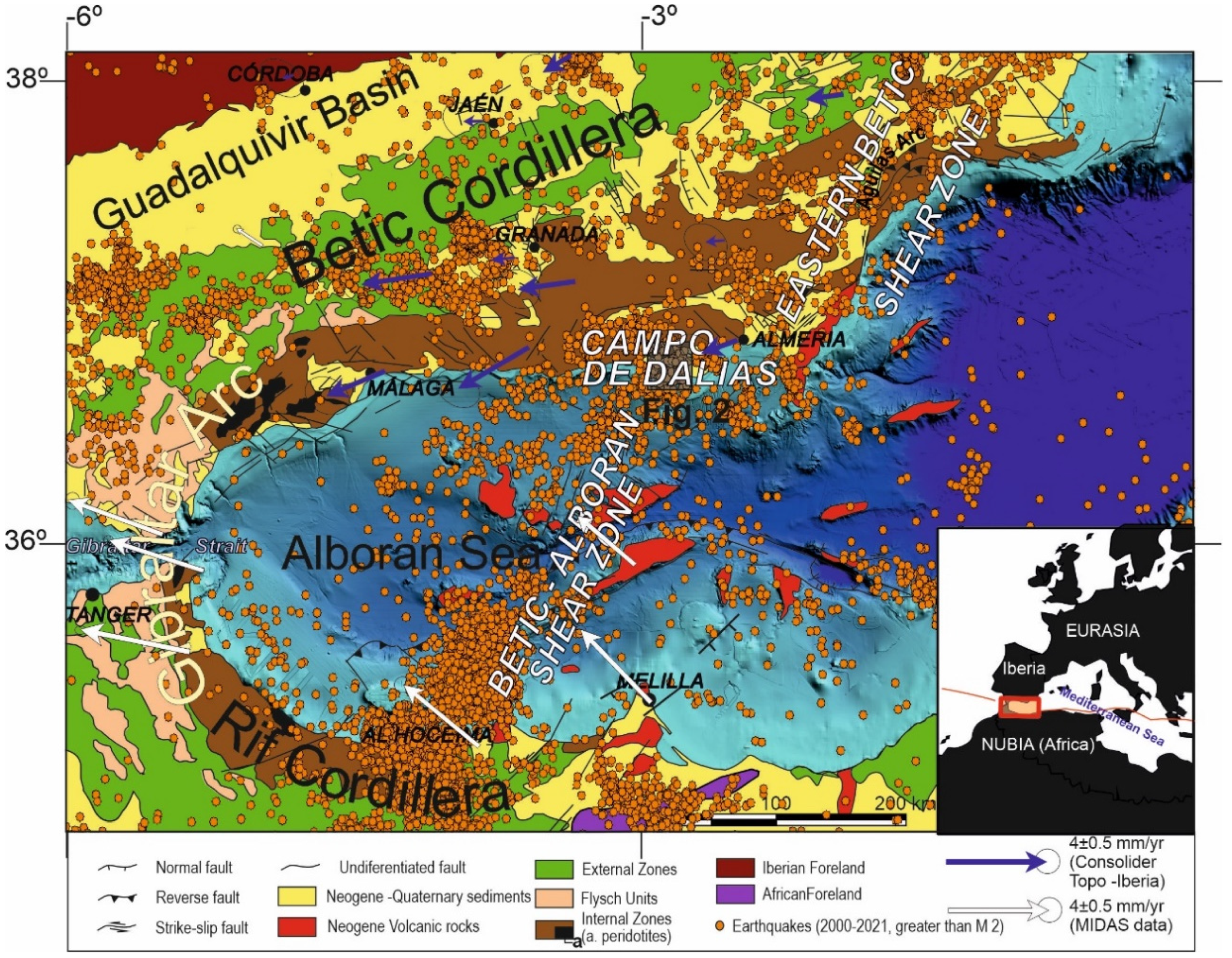

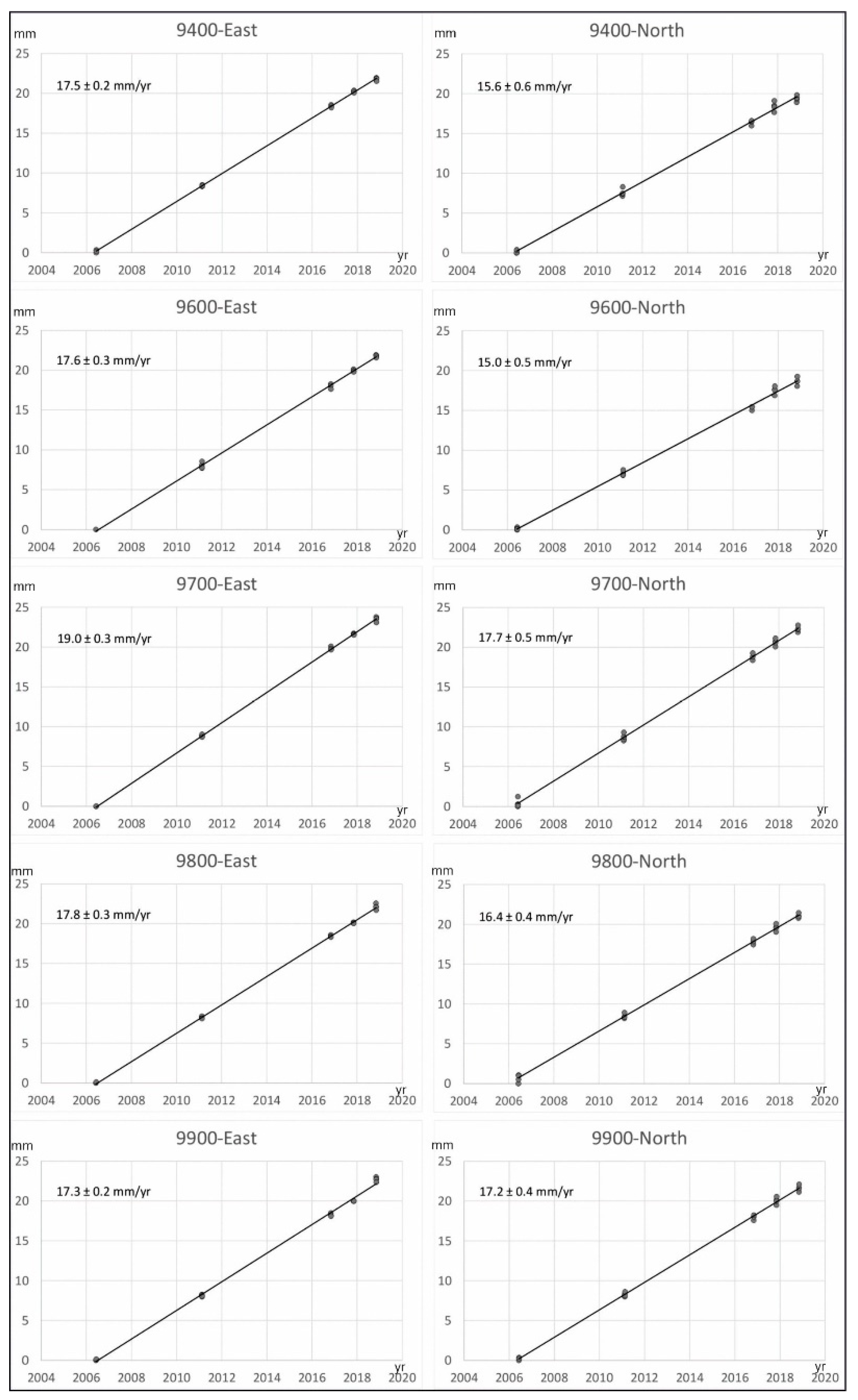

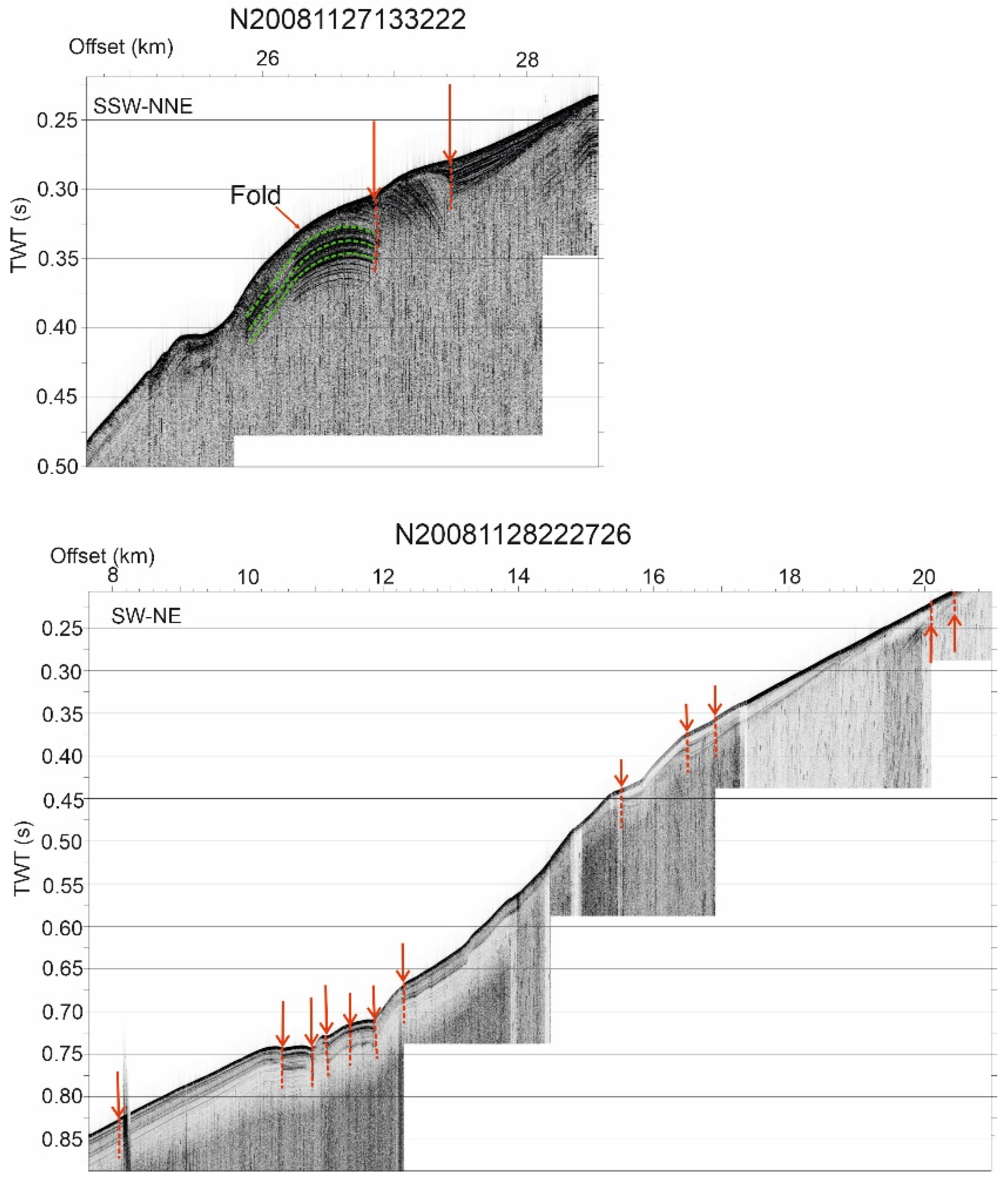
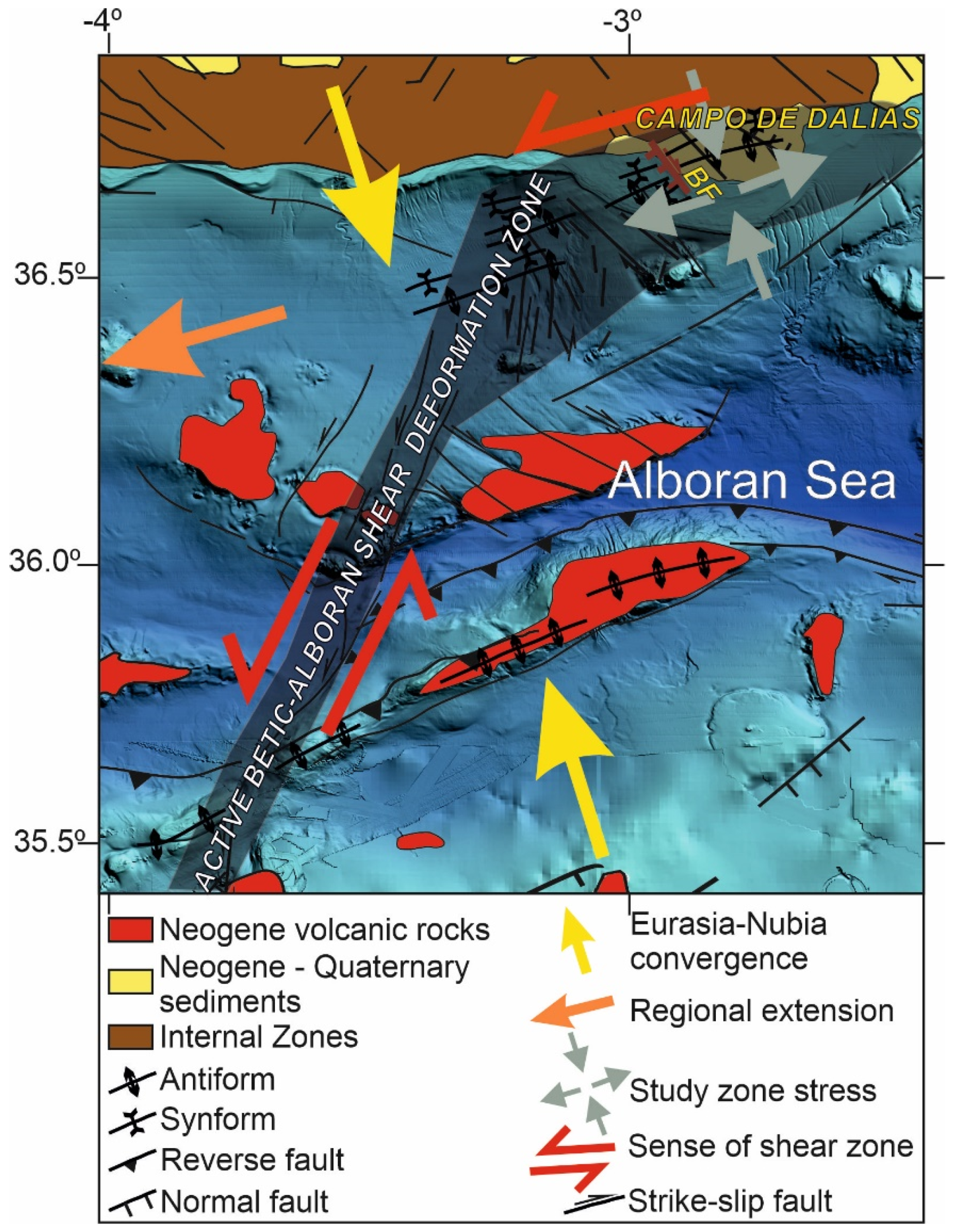
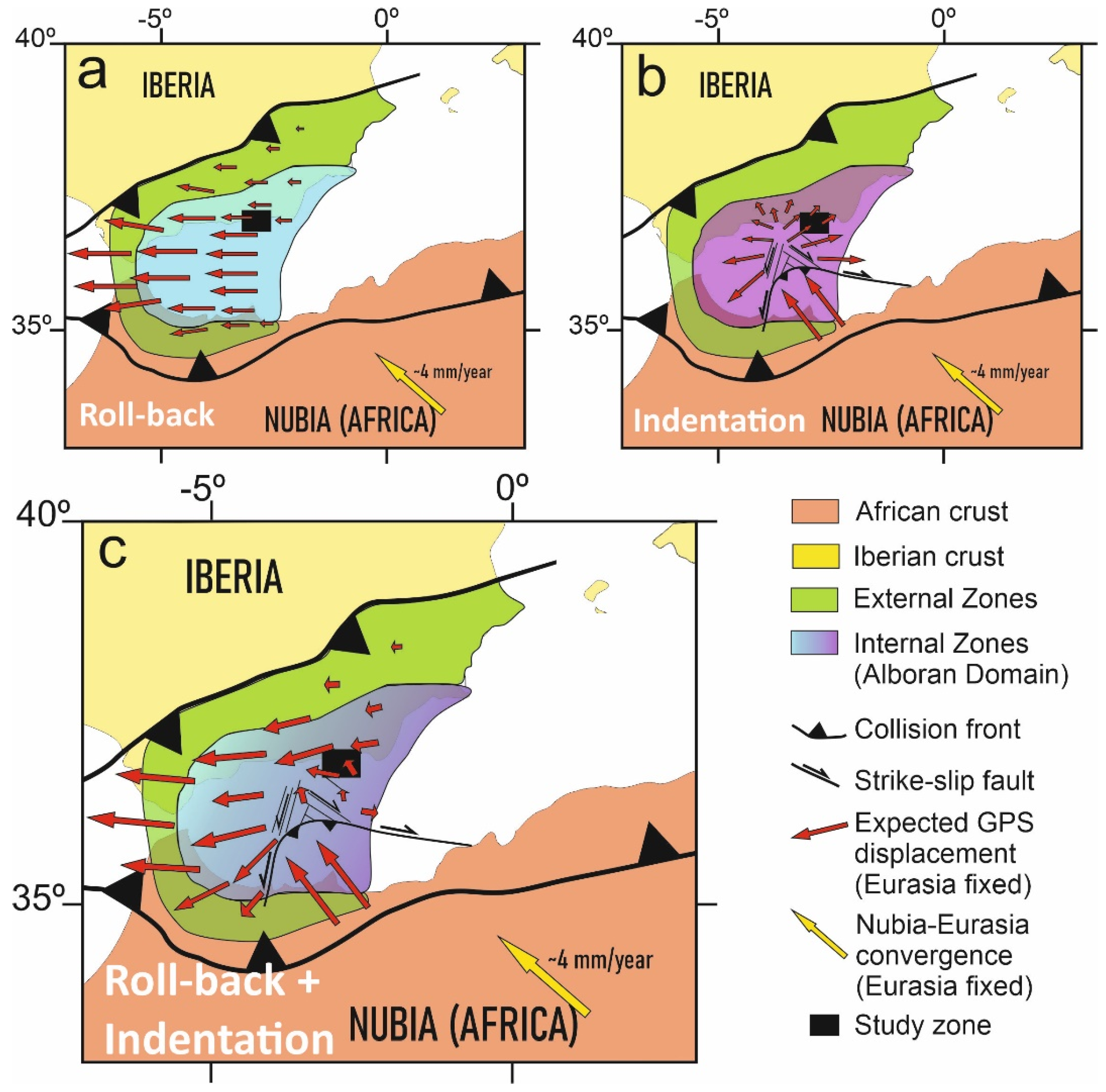
| Site ID | Velocity (mm yr−1) | Uncertainty (mm yr−1) | Residual Velocity (mm yr−1) | |||
|---|---|---|---|---|---|---|
| East | North | East | North | East | North | |
| 940 | 17.5 | 15.6 | ±0.3 | ±0.7 | −2.7 | −0.9 |
| 960 | 17.6 | 15.0 | ±0.4 | ±0.6 | −2.5 | −1.6 |
| 970 | 19.0 | 17.7 | ±0.4 | ±0.6 | −1.2 | 1.2 |
| 980 | 17.8 | 16.4 | ±0.4 | ±0.5 | −2.4 | −0.1 |
| 990 | 17.3 | 17.2 | ±0.3 | ±0.5 | −2.9 | 0.7 |
Publisher’s Note: MDPI stays neutral with regard to jurisdictional claims in published maps and institutional affiliations. |
© 2022 by the authors. Licensee MDPI, Basel, Switzerland. This article is an open access article distributed under the terms and conditions of the Creative Commons Attribution (CC BY) license (https://creativecommons.org/licenses/by/4.0/).
Share and Cite
Galindo-Zaldivar, J.; Gil, A.J.; Tendero-Salmerón, V.; Borque, M.J.; Ercilla, G.; González-Castillo, L.; Sánchez-Alzola, A.; Lacy, M.C.; Estrada, F.; Avilés, M.; et al. The Campo de Dalias GNSS Network Unveils the Interaction between Roll-Back and Indentation Tectonics in the Gibraltar Arc. Sensors 2022, 22, 2128. https://doi.org/10.3390/s22062128
Galindo-Zaldivar J, Gil AJ, Tendero-Salmerón V, Borque MJ, Ercilla G, González-Castillo L, Sánchez-Alzola A, Lacy MC, Estrada F, Avilés M, et al. The Campo de Dalias GNSS Network Unveils the Interaction between Roll-Back and Indentation Tectonics in the Gibraltar Arc. Sensors. 2022; 22(6):2128. https://doi.org/10.3390/s22062128
Chicago/Turabian StyleGalindo-Zaldivar, Jesús, Antonio J. Gil, Víctor Tendero-Salmerón, María J. Borque, Gemma Ercilla, Lourdes González-Castillo, Alberto Sánchez-Alzola, María C. Lacy, Ferran Estrada, Manuel Avilés, and et al. 2022. "The Campo de Dalias GNSS Network Unveils the Interaction between Roll-Back and Indentation Tectonics in the Gibraltar Arc" Sensors 22, no. 6: 2128. https://doi.org/10.3390/s22062128
APA StyleGalindo-Zaldivar, J., Gil, A. J., Tendero-Salmerón, V., Borque, M. J., Ercilla, G., González-Castillo, L., Sánchez-Alzola, A., Lacy, M. C., Estrada, F., Avilés, M., Alfaro, P., Madarieta-Txurruka, A., & Chacón, F. (2022). The Campo de Dalias GNSS Network Unveils the Interaction between Roll-Back and Indentation Tectonics in the Gibraltar Arc. Sensors, 22(6), 2128. https://doi.org/10.3390/s22062128







